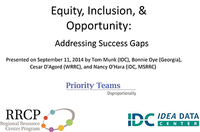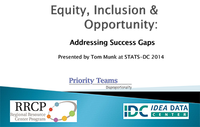This white paper outlines factors in the general education setting that contribute to equitable success for all students. The paper addresses elements of equity, inclusion, and opportunity that can minimize or eliminate success gaps that exist among groups of students. Success gaps are those differences in a variety of educational factors and outcomes that affect the likelihood of success for some groups of students compared to their peers. Some key areas of success gaps include test scores, disciplinary actions, placement in special programs, graduation, and post-school outcomes. When a school or district shows success gaps, it means that it may not be serving all groups of students equally well. The white paper provides the research-based background that supported development of a complementary rubric that school or district teams can use to systematically examine the root causes of success gaps that may exist among groups of their students. The white paper has been updated recently and now includes include considerations for children as young as preschool.
For more information about how to use this tool, view these webinar recordings.
Resource Files & Links
Companion Resources
These are resources that supplement the resource above.
Format: Guides and Briefs
Success Gaps Rubric: Addressing Equity, Inclusion, and OpportunityThis rubric allows a team of users from a district or school to systematically examine the root causes of success gaps among groups of students by focusing on equity, inclusion, and opportunity. The recently updated rubric now includes considerations for children as young as preschool age. A complementary white paper provided the research-based background that supported development of the rubric.
Related Content
Format: Guides and Briefs
Measuring Significant Discrepancy: An Indicator B4 Technical Assistance GuideThe TA guide describes the methods a state might use to appropriately determine which of its districts has a significant discrepancy (including a significant discrepancy by race or ethnicity) in the rates of out-of-school suspensions and expulsions totaling greater than 10 days for children with disabilities.
Format: Guides and Briefs
Methods for Assessing Racial/Ethnic Disproportionality in Special EducationThis TA guide addresses the more common methods for calculating racial/ethnic disproportionality in special education. IDC revised the guide, which the Data Accountability Center (DAC) originally published in October 2011, because of a change in SPP/APR Indicators 9 and 10 to remove underrepresentation from the measure.
Format: Presentations
Equity, Inclusion, and Opportunity: Addressing Success Gaps via the SSIP ProcessPresenters introduced a research-based guidance document and self-assessment rubric designed by OSEP's Disproportionality Priority Team to help districts and schools identify the root causes of "success gaps" for some groups of students, thereby helping to improve and equalize results for all students. As an example, presenters used Georgia's SSIP process, focused on graduation for students with disabilities.
Format: Presentations
Equity, Inclusion and Opportunity: Addressing Success GapsThe presentation introduces a research-based guidance document and self-assessment rubric designed to help districts and schools identify the root causes of "success gaps" (for example, in test scores, suspension or graduation rates, or course credits) for some groups of students, thereby helping schools to improve and equalize results for all students.






